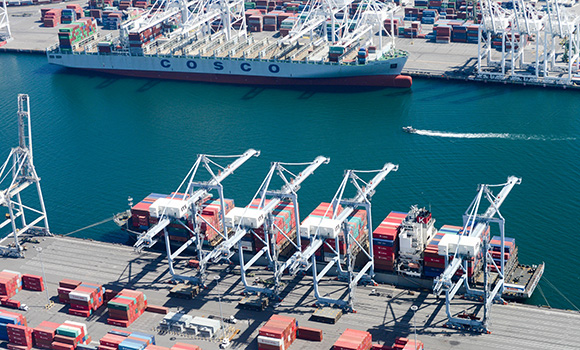
(Photo Credit: Eric Chan/Flickr)
One of San Diego’s biggest economic assets is the ocean. The region currently boasts 46,000 maritime jobs and $14 billion in revenue in what’s known as the Blue Economy. Those numbers are expected to rise dramatically as city and county officials recently adopted a “maritime vision” of the region which includes forming a Blue Tech incubator to encourage more business and job creation.
“When you look out from land, you see the horizon, you really don’t think about what’s going on underneath the surface, but there’s a lot going on,” said Greg Murphy, executive director of The Maritime Alliance a non-profit dedicated to promoting sustainable science-based ocean and water industries. “So these technologies are right here in our hometown, in our region and across California, but because they’re so heavily export oriented and they’re addressing an area that’s out of sight and out of mind, a lot of these companies have gone under the radar.”
According to a report issued earlier this year from the Organization for Economic Cooperation and Development, the global Blue Economy will double from $1.5 trillion in 2010 to a conservative estimate of $3 trillion by 2030. This economy includes many different marine-based sectors including transportation, energy (renewable and fossil), research, security, communications and aquaculture.
Added Murphy, “The Blue Economy and Blue Tech sector is quite broad in its spectrum of jobs, everything from low-wage assembly, basic manufacturing and advanced manufacturing, to middle-wage, really good paying blue collar jobs to high paying white collar jobs.”
MiraCosta College’s Technical Career Institute is training workers for these new jobs through a four month certificate program. “Our students come in the engineering tech program,” said Linda Kurokawa, The Institute’s director of Community Education & Workforce Development. “They learn the basics of electronics, mechanical automation, robotics, hydraulics, pneumatics and 3-D printing. Once they’ve learned a concept, then they discuss it and have guest speakers and visit industries where there is something having to do with ocean technology.”
Students work in a small lab setting with state-of-the art equipment and supplies. The normal cost per student to complete the program is $6,700, which made it out of reach for many. But Kurokawa and her team applied for and received a Department of Labor grant through America’s Promise and now allows students to enroll in the program for a nominal administration fee. The grant also includes funds for education and capacity building through The Maritime Alliance.
According to Kurokawa, students who complete the program are finding success. “Our advanced manufacturing and engineering tech courses have an over 90 percent employment rate and an over 90 percent retention rate.”
The program includes a work-skills navigator who works with both the local industries to make sure students are trained to meet their needs and with students to make sure they stay on track and assist in job placement upon the program’s completion. The students include a wide range of demographics from veterans to recent high school graduates with an average age of 32 years.
“So this this is really neat technology that’s happening with Blue Tech and I’d love for our graduates to go into these companies that are developing these new technologies that are really conducive to sustaining our planet and sustaining our population as it grows and not causing more harm to the planet,” said Kurokawa.
The Maritime Alliance is also preparing a future workforce at a younger age. In partnership with the San Diego Unified School District, a pilot platinum-level career pathway is scheduled to start this fall at a middle school and continue to the local high school in what will eventually be a 6-12 Blue Economy academy.
By using its largest natural resource, California has the ability to not only grow its workforce, but also create sustainable technology that will benefit the entire planet. At the 2017 California Economic Summit happening in November in San Diego (Registration and Information), business, civic and higher education leaders will meet to discuss strategies, like MiraCosta's training program, that can grow a strong workforce in a responsive way.
“If we can do it in San Diego, it can be replicated anywhere because we’ve got so many different pieces of the puzzle here with the huge Navy presence, strong environmental advocacy organizations with interest from aquaculture,” said Murphy. He added that San Diego has one of the last remaining shipyards on the West Coast, a substantial commercial fishing industry and world class research and educational institutes such as Scripps Oceanography. “This is the right place to perfect the model and, once it’s done, it can be replicated across the rest of California.”

